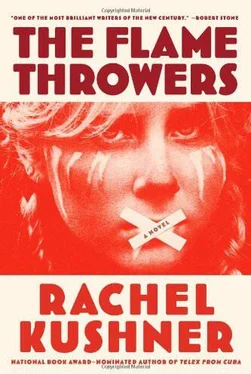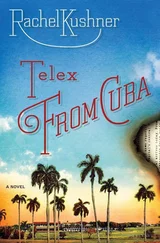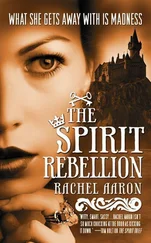Cars were being rolled from the test area, salt piled in a ring around the tread of each tire like unmelting snow. I filled out my registration form and waited to have the bike inspected. The Valera motorcade arrived, a convoy of trucks, trailers, and air-conditioned buses with tinted windows and industrial-grade generators. They parked in their own separate area of the salt. It was roped and off-limits. I turned in my form. I had a couple of hours before they would run my class. I walked over to the start line. The men who clocked the start were like the men I’d seen in the Mexican restaurant the night before, big mustaches, wearing sunglasses and ear protection headphones, walkie-talkies strapped to their chests, over their officials’ jackets.
For land speed records, each driver has the course to himself. You race by yourself, but your time is relative to whatever class you race in — in my case, unmodified 650 cc twins. No one else shares the course, so vehicles run endlessly throughout the day, a coming and going in the bright white heat, each calamity or success on the scale of individuals. There were two long lines, short course and long course. In the lines were every kind of car and bike, dragster cycles with eight-cylinder motors, streamliners like warheads put on wheels, the drivers coffined flat on their backs in tiny horizontal compartments, inches above the salt, and the elegant lakesters in polished aluminum, rounded and smooth like worn bars of soap, their fender skirts almost grazing the road. There were old-fashioned roadsters with gleaming new paint, roll bars, and big stenciled numbers on the doors. Vintage American muscle cars. A pink-and-yellow 1953 Chrysler Town & Country, a Technicolor mirage bouncing along on shot springs.
After my one year in New York I had practically forgotten there was a world of elsewheres, people who lived outside the city and recreated in their own style. There were a lot of family-based teams, and in a few cases, the mother was the driver. Not many, but I was not the only female, though I may have been the only woman on a motorcycle. There was the joke of the bump-start vehicle, which gave the racers a boost from the start line. Anything on wheels and that ran could work: A school bus. A just-married jalopy, trailing cans. An ice cream truck. The more elaborate and professional the race car, the more ridiculous and lavishly impractical its bump-start vehicle seemed to be. Although I was wrong about the ice cream truck. It pulled up and opened for business, pencil-necked boys lining up at the window. An ambulance came, and I wondered what happened, and how serious the injury was. But the ambulance was a bump vehicle, pushing a lakester off the start line, the ambulance driver wearing a white medic’s shirt and costume bandages soaked in fake blood.
Every few minutes an engine screamed as a vehicle flew off the line, spewing a rooster tail of salt from under each rear tire. A few seconds into its run the vehicle began to float, its lower half warbled. Then the whole thing went liquid and blurry and was lost to the horizon.
One after another I watched the scream, the careen, the rooster tail, the float, and then the shimmer and wink off the edge of horizon, gone.
Careen, rooster tail, float, gone.
Careen, float, gone.
There were lots of us watching. Drivers, kids, wives, technicians. All we had, to track the action, after the vehicle twinkled and melted into nothing, was a crackle on the timing officials’ two-way radios. I felt myself bracing for bad news after the crackle. Anticipation was structured into the logic of the place. We weren’t waiting to hear the run was routine, that it was solid, that there were no problems. Standing behind the start line, there was nothing to see as a car entered the measured mile. We weren’t there to see. We were waiting on news of some kind of event, one that could pierce this blank and impassive and giant place. What else could do that but a stupendous wipeout? We were waiting on death.
* * *
My final project in art school was a film about Flip Farmer. I’d contacted him at his shop in Las Vegas to request an interview, but he wouldn’t agree to it unless I paid him five thousand dollars. He seemed to make no distinction between an impoverished art student and Look magazine. I took a risk and knocked on his door. He lived on the bluffs above the strip. A curtain was pulled aside and quickly shut. No one was going to answer. I had a super-8 camera that I panned around the premises, past a tire swing, unmoving in the breezeless day, broken toys, lawn chairs that someone was stripping of upholstery and bending into scrap aluminum. Several project cars up on blocks — shade tree work, as Scott and Andy called it. “Hey, you can’t film here! Hey!” It was a woman’s voice, from beyond a window screen. I figured I’d better go.
A friend of mine from school named Chris Kelly had tried to make a documentary about the singer Nina Simone, a similar scenario of knocking on her door. He had tracked her down to the South of France. Nina Simone opened her front door in a bathrobe, saw that the visitor was holding a camera, lifted a gun from the pocket of her robe and shot at him. She wasn’t a good shot. Chris Kelly, who had turned and run, was only hit once, a graze to the shoulder, as he tore through the high, wet grass beyond her farmhouse. He got no footage of Nina Simone but I somehow saw this robe from which she had produced her gun. Flowy and feminine, pink and yellow flowers with greenish flourishes, semi-abstract leaves. Nina Simone’s brown legs. Her flat, calloused feet in a pair of those unisex leather slippers that Europeans like Sandro wore around the house. She shot Chris Kelly, after which he became a legend at UNR. Or at least he was a legend to me. Being fired at with a gun made an impression; it elevated what he did from a student project to actual art. It was somehow better than if he’d filmed her in a typical documentary style. Chris Kelly moved to New York City a year later and became doubly a legend to me, the guy shot by the singer and also the one who moved to New York.
After I’d left Flip Farmer’s place on the bluffs I drove along the Las Vegas Strip at dusk, the camera filming my own departure, casino neon flashing beyond the windshield of the car I’d borrowed for the trip. Stoplight. Man in a white cowboy hat, crossing. Signs stacked up against high mountains. Chapel, Gulf, Texaco, motel, family units, weekly, pawn, refrigerator, fun. A slow proceeding through town and out. No Flip. A Flipless film about Flip. It wasn’t bad, and when I first got to New York, I mostly made short movies that were like the tracked retreat from Flip’s. They were wanderings, through Chinatown at night, or into abandoned buildings on the Lower East Side. I didn’t know what I was looking for. I filmed and then looked at the footage to see what was there.
Sandro had told me about one of Helen Hellenberger’s artists who had done a drawing by walking in a straight line across a mile of the Mojave Desert and marking it in chalk. It was almost feminine, Sandro joked, to walk . Contemplation, nature, submitting passively to the time it took.
The time it took : that was when I had gotten the idea to do this. What about going as fast as you possibly could? I’d thought. And not marking it in chalk. Drawing in a fast and almost traceless way.
* * *
I’d spent half a day among those waiting on death and now I was in line for the long course and hoping I was not the sacrifice.
Perhaps because I was one of the few women running a vehicle that day, the timing officials let me store my knapsack and camera with them while I did my run. Everyone loved the bike. It was brand-new, there was a waiting list to order them from every dealership in the United States. Even the Valera people came over to admire it. I didn’t explain that I was Sandro’s girlfriend. I simply let them admire the bike, or admire the idea of an American girl riding it. Didi Bombonato was not among the Valera people who came over to say hello, see the bike. Didi Bombonato was in the air-conditioned bus. He would make his run later, when the salt was closed to everyone else.
Читать дальше












